Archive for ‘Productivity’ Category
Toss Old Socks, Pack Away 2023, and Adjust Your Attitude for 2024

I don’t know about you, beloved readers, but 2023 has been a rollercoaster.
In January, someone rang my doorbell late at night to tell me they’d hit my car in the parking lot; in August, my car was stolen. And in November, just ten days before she was set to join us for Thanksgiving, Paper Mommy fell and fractured her pelvis in two places, and then developed pneumonia 48 hours later, and complications after that! (As of this weekend, she’s finally home and recovering.)
I’m a positive person, but when the TV ads promote stage productions of Annie and the music swells for “The Sun’ll Come Out Tomorrow,” I’ve been struck by a powerful urge to throw the remote through the screen.
Professionally, 2023 was a mixed bag. I’ve maintained and added wonderful clients to my roster, and had a dazzling variety of in-person and virtual speaking engagements. But I was also saddened when a cherished elderly client passed away, and I must confess to not having made any headway on a passion project I’d wanted to write.
This is the traditional time to look back and pack away the prior year and set the tone for the one to come.
Letting go of what’s awful or unnecessary comes as second nature to professional organizers; it’s almost therapy to us. For example, I’m not much for Black Friday, but I used the opportunity to replace almost all of my socks with snazzy new ones and jettisoned the old, sad ones. I’m ready for a new foundation, literally and figuratively.
Evaluating and state of a hosiery drawer and replacing all of hole-y socks is easier than doing a deep dive into how we’ve lived our lives over the past year and designing change for the coming one, but they are similarly life-affirming and necessary.

Editor’s Note: if you want to feel doubly-good about getting new socks, consider Bombas, which donates a pair to unhoused individuals for every pair you buy, or John and Hank Green’s Awesome Sock Club, where 100% of the profits go to a charitable organization working to decrease maternal and child mortality in Sierra Leone.
LOOK BACKWARD AND EMBRACE THE PERSONAL ANNUAL REVIEW
There are myriad ways to reflect on your past year, with multiple purposes. The main categories you might want to consider are:
- Health — Please don’t focus merely on weight, but consider stamina and strength, lab results, mental health, and health-related habits (both positive and unsavory).
If you don’t know how you’re doing in these areas, calling to make appointments with specialists and getting a handle on your numbers and benchmarks is a good place to start in the new year.
Don’t have a primary care provider or dentist or OB/GYN? Behind on your immunizations or age-appropriate health screenings like mammograms or colonoscopies? Make 2024 the year to catch up on your adulting! (In 2022, I finally got my overdue tetanus booster, an important one for professional organizers. We never know when something sharp is going to jump out and bite us!)
- Finances — Your bank balance doesn’t tell the whole story.
Did you stay within your budget? (Do you actually have a budget?) Are you comfortable with your rate of savings over the past year? Did you make good or bad investments (or avoid signing up for that 401K at work because you didn’t understand how it worked)?
Is your credit score trending up or down? Are there mistakes on your credit reports, or have you not even checked AnnualCreditReport.com since before the pandemic…or ever?

Dollars Photo by Alexander Grey on Unsplash
- Professional Development — If you work for someone else, prepare for your company‘s annual review (likely done on your work anniversary) by asking:
- What were the top projects I worked on this year in terms of financial return or impact? Am I happy with my contributions? Did I meet expectations? Exceed them?
- What achievement am I most proud of? Where did I fail to hit the mark of expectations, either my own or the company’s?
- What do I wish I had known or done earlier in the year to have improved my performance? What training, skills, knowledge, resources, or support do I need to make my performance next year better?
- Business — If you own your own company, business development means all of the professional development category, plus a much more detailed analysis. Look at all of your goals, not only to see if you achieved them, but to understand how you can improve their specificity, measurability or relevance the next time around.
Do you know where your clients or customers came from? Do you know how satisfied they are with your service or products? What are your metrics for sales, followers on your social media platforms (and interactions with those followers), newsletter subscribers, and your standing in the community?
Competition doesn’t matter as much as client satisfaction, but neither matter if you have no idea how your company (of one employee or one thousand) is trending.
- Relationships — Nobody can tell you what your relationships should be, but if you’re not feeling loved and supported most of the time in your interactions with your partner, family, and friends, it probably won’t get better on its own. Organizing relationships matters!
Identify areas of improvement, like better communication or ways to nurture one another and connect. Maybe you just need to cook and eat meals together, which a recent study has found leads to well-being.
Perhaps you need to consider whether this relationship has outworn its welcome. Just as with clutter, people buy into the sunk-cost fallacy; instead of throwing good money (or time) after bad — whether it’s an outgrown/defective car, gadget, or relationship — sometimes the best thing we can do is break free of inertia and let it go! (Cue Frozen!)
- Intellect and Education — What did you learn in 2023? What did you read or listen to that made you better at what you do or in terms of who you are? Students get report cards; as adults, it’s harder to evaluate our intellectual growth.
Try writing reviews of the books you read or tracking them in a notebook, or online in an app like Goodreads. (With only two weeks to go, I doubt I will hit my Goodreads Challenge goal of 39 books this year; I’m at 28 and will probably only finish two or three more. But that’s probably more than I’d finish if I didn’t keep track.)
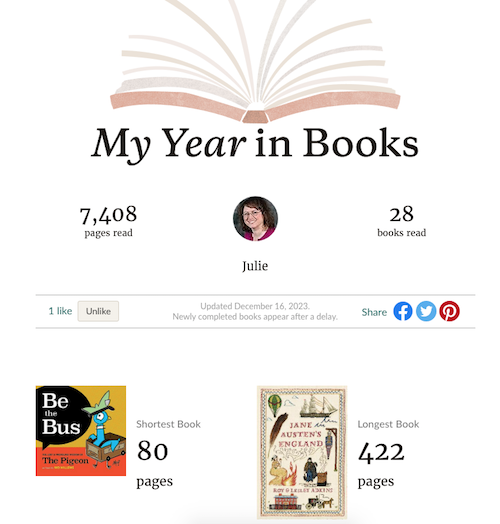
- Personal Growth — What’s different about you now versus last January? Have you grown in any way that’s discernible to your others or yourself? Did you embrace any new hobbies or skills?
If you’re happy with your life, huzzah! But if you feel like there was something missing in 2023, or if you participated in activities that no longer float your boat, now’s the time to explore and set some goals with actionable benchmarks for enriching your life. Make time for hobbies and passionate pursuits, and make room in your schedule for serendipity to offer you surprises!
- Community — Do you have a community outside of your work? Whether it’s social, political, charitable, spiritual, or otherwise, do you feel like you were involved in something bigger than yourself this year? How (and with whom) do you want to move forward next year?
WHAT TO DO WITH WHAT YOU LEARN FROM YOUR ANNUAL REVIEW
Knowing how you did is only the first step. Next, focus on three activities: Celebrate, Acknowledge, and Grow!
Celebrate
When I worked in television, I had a wonderful general manager who used to say, “One ‘Aw, <bleep>!’ wipes out ten ‘Atta-boys!'”
While his salty statement was designed to address public perception, it also calls to mind that even if we celebrate our successes in the moment, when we sit down to evaluate how we’ve done, we tend to focus on our failures and our shortcomings. With the perspective of weeks and months, we can revisit the areas of our lives where we’ve done well (or at least we did better than circumstances might have otherwise allowed).
Go through your calendar, emails, and task lists and find the wins! And because we can be unreliable narrators of our own lives, ask your partner, closest friends, mastermind group, and/or colleagues. You may be delightfully surprised by the successes you’ve forgotten while focusing on the day-to-day or even the fumbles.
Acknowledge
Yes, we do fumble. At work, with our families, with our promises to ourselves. We fail to aspire by believing we cannot succeed in organizing our spaces or our time or our lives, or we aspire without realistic planning, writing checks our overwhelmed future selves can’t cash.
The point isn’t to get mired in where we’ve fallen short, but to cash in our reality checks, measure our ending points against our starting visions, giving ourselves credit and then acknowledging what we must do differently. Do we need new goals and aspirations, or do we need to seek professional help, comradeship/support, and different tools?
Grow
There is little point to looking back as a pure exercise unless we plan to sit on our laurels or self-flaggelate. Instead, we should use the knowledge of our past year to determine what we want our next year to reflect. Often misquoted or truncated, there’s an excellent quote by Dr. Maya Angelou:
“I did then what I knew how to do. Now that I know better, I do better.”
After evaluating your year, ask yourself how you want to do better. Do you really want to lose weight to hit an arbitrary number on the scale, or do you want to feel more comfortable and more confident in your clothes? Do you want to jump on the fitness trend everyone else is trying or do you want to explore something that fits your needs and workout style?
I recently learned that our ability to get off the floor by ourselves, without using our hands, is highly correlated with longevity. So, even though I start every year wishing I were good at yoga (and not both klutzy and bored to tears by it), for 2024, I’m looking at continuing my 10+K walks, getting back into Pilates, and exploring functional workouts designed to help improve stability and strength. I’m also giving myself a benchmark date by which if I haven’t gotten into a regular routine beyond walking, I’m going to hire a coach to guide me on functional aging skills.
If you aren’t happy about (or aren’t feeling informed on) your finances, start by gathering intelligence. Your credit cards likely have a dashboard that sorts your expenditures into categories you can evaluate, like restaurant service delivery or monthly fees for apps you’re no longer using. Look for “spend analyzer” or “year-end summary” on your financial account apps to note trends. If you’ve been using Mint as an independent financial dashboard, note that Intuit is suspending it and moving some (but not all) of its functions to Credit Karma, so you may need to find an alternative.
PICK YOUR ANNUAL REVIEW STYLE
I know from experience that I flounder when trying to do a free-form annual review, so over the years, I’ve embraced Year Compass, which I learned about from Janet Barclay. Year Compass is free, downloadable and fillable, printable PDF. (It’s available in translations to dozens of languages.)
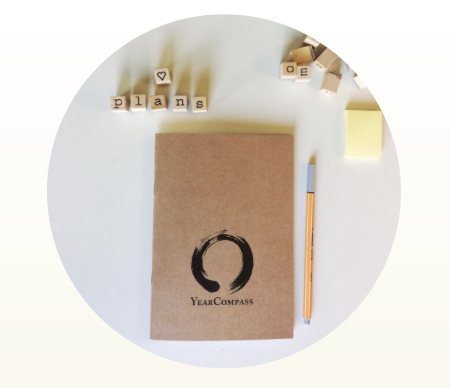
Just print the booklet version and fill it out by hand. (Be sure to set the page to US English to get North American paper measurements.) Alternatively, you can type your answers directly into the digital version. (My penmanship gets more unwieldy each year, but I think we all feel more connection to the past year’s version of ourselves if we hand-write responses.)
Explore the innovative questions to generate a thorough evaluation of how your past year turned out and how to approach the coming year. Do this on your own or with a group of friends or family after a yummy at-home brunch.
In last year’s post, Organize Your Annual Review & Mindset Blueprint for 2023, I talked about the importance of evaluating your year based on your personal values, as well quantitative and my own list of qualitative questions, which I’ll share again:
The Good
- What challenges made me feel smart, empowered, or proud of myself this year?
- What did I create?
- What positive relationships did I begin or nurture?
- Who brought delight to my life?
- Who stepped up or stepped forward for me?
- What was my biggest personal highlight or moment I’d like to relive?
- What was my biggest professional moment I’d want to appear in my bio?
- What’s a good habit I developed this year?
The Neutral
- What did I learn about myself and/or my work this year?
- What did I learn how to do this year?
- What did neglect or avoid doing out of fear or self-doubt?
- What did I take on that didn’t suit my goals or my abilities?
- What was I wrong about?
The Ugly
- What challenges made me feel weaker or less-than?
- Whom did I dread having to see or speak with this year?
- Who let me down?
- Whom did I let down?
- What did I do this year that embarrassed me (professionally or personally) or made me cringe?
- When did I hide my light under a bushel?
- What am I faking knowing how how do? — Instead of pretending you know how to do something but are choosing a different path, ask for help. Make decision about what to do from a position of strength rather than weakness.
- What’s a bad habit I regret taking up or continuing?
- Where did I spend my time wastefully or unproductively? (It’s social media. For all of us.)
- Where did I spend my money wastefully or unwisely? (Target? Let’s take a poll. Was it Target?)
WHY LOOK FORWARD?
Unless you’re a fourth grader watching the clock tick down until recess, time moves too quickly. We have little opportunity to savor the good, and before we know it, the years have flown by. If I don’t plan for how I want to live my future, time will go by without achieving what I want. To remind myself of the brevity and value of each day (without getting too maudlin), I use the simple but motivational app Life Clock.
Life Clock, available for iOS and Android, envisions a lifetime as the equivalent of a 24-hour clock. You feed it limited personal information and it extrapolates your life expectancy (though you can always adjust the number). It then identifies, for the given date, what “time” it is in your life.
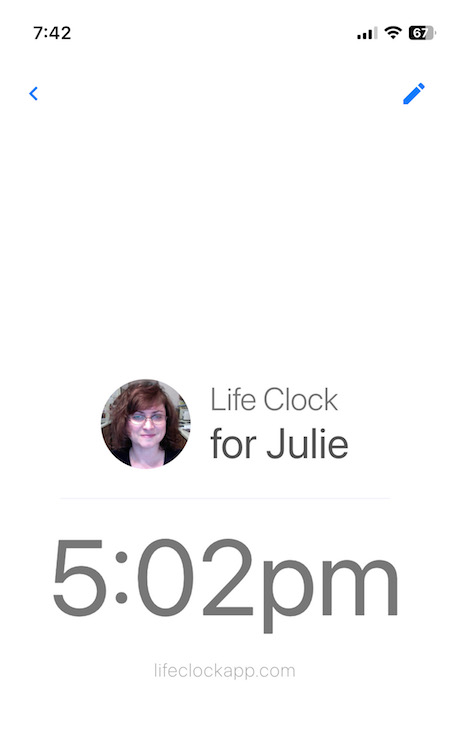
Gulp!
Life Clock shares mini-facts about how to extend your lifespan (and notes what shortens it), and details historical trends and where traditional benchmarks (like graduating and moving out of your family home) fit on the clock of life. Each minute of your “life clock” equals about 20 days in real life.
We don’t need to “optimize” every bit of our lives; we deserve downtime. But we only get 1440 minutes in a real day, so let’s not waste a single one of our life clock minutes on things that aren’t good for us and don’t make us happy.
Nobody gets to decide for you what matters most. That said, it’s hard to stay focused on what matters to you when kids and world events and who Taylor Swift is dating all get in the way.
RESOLVE TO GIVE UP RESOLUTIONS
As I’ve written for many years, I don’t think resolutions work; they lead to disappointment and frustration. Why?
- People set unrealistic expectations. Resolutions are often overly ambitious and fail to account for the time and effort you need.
- Not all goals have to be SMART goals, but if your resolutions lack specificity (“get out of debt” or “get it shape,”), you have no actionable steps to take.
- Most resolutions have no real plan of action and no method for achieving accountability.
- Far too many resolutions have no intrinsic motivation. If your resolutions are designed to make someone else happy (whether that’s your mother-in-law or society) or compete (with a societal ideal or another individual), you’re bound for misery. I prefer SMARTY goals that are specific, measurable, achievable, relevant, time-based, and most importantly, yours.
- Too many resolutions are made and evaluated with all-or-nothing thinking. Success based on perfectionism is demotivating. Give yourself grace.
Instead of resolutions, focus on changing your habits. I’ve written about this at length, including in Organize Your Life: The Truth About Resolutions, Goals, Habits, and Words of the Year back in 2019 and earlier this year in Paper Doll Helps You Find Your Ideal Analog Habit Tracker.
So read those two posts, and for real, meaningful change, read Charles Duhigg’s The Power of Habit: Why We Do What We Do in Life and Business
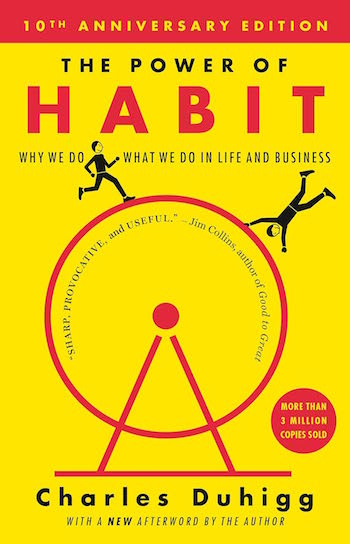
and James Clear’s Atomic Habits: An Easy & Proven Way to Build Good Habits & Break Bad Ones.
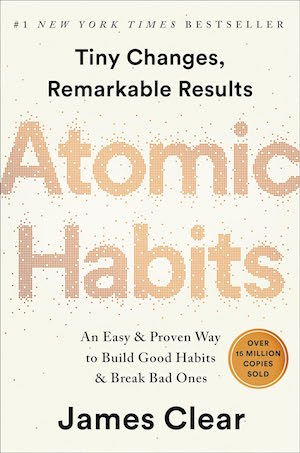
We don’t change who we are just because we decide to. We need a game plan. I will never embrace brevity in talking or writing. I will never be a morning person. But, I can change my habits. And so can you.
PROMOTE YOUR 2024 PLAN TO YOURSELF
Along with habit changes instead of resolutions, I believe in boosting your mindset so you can remind yourself, regularly, that you want to live a certain way, and why.
In the annual review/forward-looking posts I’ve linked to throughout this post, I’ve done deep dives into ways to keep the motivation and energy of your “why” alive. You can read about them in detail, but they include:
- a word of the year
- multiple words (like a trio of words) of the year
- a quote or motto or mantra of the year
- a song of the year
Whatever you pick, this word or phrase or song is your personal theme for the coming year. It reflects what you want to remember about your goals and your attitude. We all know that advertising works, so whatever you pick, or however you combine these ideas, use your (organized) space to keep your attention on your intention for the year.
Promote your theme word or phrase or song — to yourself — on a vision board to reflect and encompass any or all of your motivating words, phrases, and songs. Post your message to yourself on your bathroom mirror, your fridge, the inside of your front door — anywhere that it will give you a boost! Change your wakeup alarm on your phone to your song theme!
PAPER DOLL’S WORD OF THE YEAR FOR 2024
Some years, I do better than others with my word choice. In 2020, I picked “ample” and embracing the phrase “Ample: it’s not just for bosoms anymore.” I’ve carped about how the “ample” opportunities for experiencing a global health crisis weren’t appreciated, but upon years of reflection, I did grow the virtual organizing and productivity coaching side of my business.
2021’s “delighted” kept me seeking opportunities for delight, but I never managed to find a word that fit well for 2022. This year, I chose “fulfilled,” and it was a guiding principle behind work and life choices.
So far, I have two contenders for 2024.
One option came to me mid-summer in a flash, so I wrote it on the December page of my calendar so I wouldn’t forget. The word is UPGRADE.
I have a habit of overthinking a word’s unintentional implications. (Like how the year I picked “resilient,” I ended up with too many things from which to bounce back.)
Upgrade, though, has real potential. While there might be a slight implication of expense — having to replace things — I really feel the vibe of improvement. This isn’t about upgrading tangible things (socks notwithstanding) but about the quality of my experiences.
But “upgrade” has a quirky competitor: PRONOIA.
Don’t worry if you’ve never heard of it. Honestly, the first time I heard the word, I assumed it was made up. It’s opposite of paranoia; a person experiencing pronoia believes that the world around them conspires to do them good. Obviously, taken to extremes, it might seem like psychological or spiritual irrationality.
But Buddist principles haven’t been working for me, I’m still trying to get a handle on the Stoics I talked about in Toxic Productivity Part 2: How to Change Your Mindset. I feel the pull of a bigger change in my life, and I think “pronoia” dovetails with the idea of a life upgrade.
Thus, I keep coming back to the Carly Pearl song in which I first heard the word “pronoia.”
While song is about psyching oneself up after a heartbreak, there’s something in the lyrics (and Pearl’s intonations) that I find inspiring.
You ever heard the word Pronoia?
It’s the opposite of paranoia, pronoia
The belief that the world conspires in your favor
Honey, it’s a game changer
It’s a cherry lifesaver
When I feel like everything is breaking down
It’s the dip before I hit the higher ground
(©2023 Carly Pearl, Renee Hikari, and David Baron)
How do you feel about the year that’s ending? What word or phrase or song is emblematic of what you want in 2024?
Take a Break — How Breaks Improve Health and Productivity
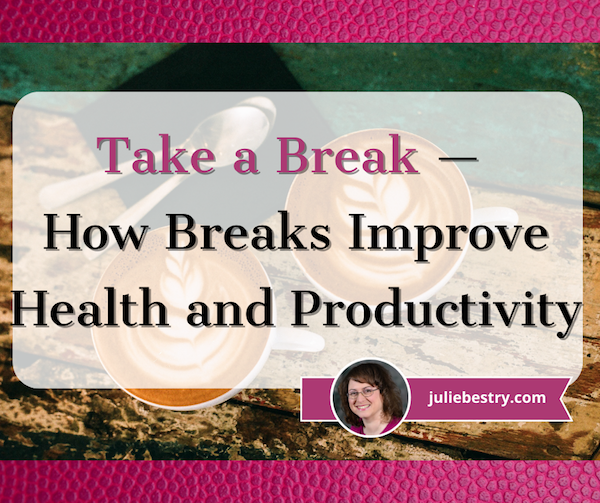
If I asked what the single best thing you could do to improve your productivity was, what would you say? Would it be doing a brain dump of your tasks? Prioritizing what you need to do? Making a list? Avoiding multi-tasking? Eliminating interruptions?
What would you think if I told you that the best way to get the most out of everything you are doing is to stop doing it for a little while?
I know, it may sound counterintuitive, but taking a break instead of spending your day trying to power through is exactly what’s needed for your body, your brain, and your spirit, not to mention the actual work.
It may sound counterintuitive, but taking a break instead of spending your day trying to power through is exactly what's needed for your body, your brain, and your spirit, not to mention the actual work. Share on XLet us not forget the trouble Alexander Hamilton found himself in when he failed to take a break. First, Eliza begged him to step away from his efforts to create a national banking system and pay attention to his son’s performance. (It’s a pity Lin-Manuel Miranda didn’t insert a verse from Cat’s In the Cradle!) Then his wife and sister-in-law begged him to “take a break,” and join them at their father’s place in upstate New York instead of struggling on in New York City.
(And, as fans of history and/or the musical Hamilton know, the failure to take a break from single-mindedly focusing on defeating Jefferson, et. al., and controlling the American economic future led, at least in part, to Hamilton making a poor personal decision (regarding Maria Reynolds), which led to others thinking he’d made a poor ethical and professional decision, which led to Hamilton blowing up his personal and professional lives. The whole second act is a testimonial for the vital importance of taking a break!)
But we don’t have to interpret musicals to know that taking breaks from our work or studying is essential for happy, productive lives. In “Give me a break!” A systematic review and meta-analysis on the efficacy of micro-breaks for increasing well-being and performance, researchers analyzed the results of 22 independent studies on the efficacy of work breaks for “enhancing well-being (vigor and fatigue) and performance.” They found that breaks were essential for replenishing mental and physical energy after work-related depletion, and that the more depleting a task is, the longer a duration of break is needed.
And if neither musical arts nor academic research is enough to convince you, how about the effect, not only on workers, but on work? Eight years ago, an NPR piece, We’re Not Taking Enough Lunch Breaks. Why That’s Bad For Business, noted that only one in five people were stepping out of the office at lunchtime. The point wasn’t eating at work, but not stepping away from work. As we’ll see, that undermines our bodies, our minds, and the quality of the work we perform.
WHAT COUNTS AS A BREAK?
A break can be of varying durations for varying activities. How long does a break need to be to have a positive effect? That depends on the work you’re doing, how much energy it depletes, and the kind of break you’re taking.
How to Take Better Breaks at Work, According to Research from the Harvard Business Review, notes that shorter breaks can be effective but that the timing of breaks is also vital. For example, because fatigue intensifies as the day goes on, short (or at least shorter) breaks are more effective in the morning, but by late afternoon, longer breaks are necessary to yield positive results.
So, what length breaks should we consider?
20–20–20 Rule
This rule simply instructs that every twenty minutes of screen time, look away from the screen and focus on something at least twenty feet away for at least twenty seconds.
The 20–20–20 Rule is designed to prevent computer vision syndrome, particularly digitally-induced eye strain. Taking a break like this can also help reduce blurred vision, headaches, dry eyes, and neck and shoulder pain.

Eye Chart Photo by David Travis on Unsplash
Regular screen breaks of just one-third of a minute will give your baby blues (or browns or greens) much-needed rest, but maybe more. When something (like a phone alarm or alert on your screen telling you, “Look away! Look away!”) prompts you to take this momentary break for your vision, you’re likely to adjust more than your eyesight.
When you’ve been in flow, focused intently on what you’re reading on the screen, you’ve probably failed to pay attention to your posture (so you maybe slumped forward toward your screen) and your breathing. This super-quick break shakes everything loose.
Short Breaks
A short break would be anything that takes less than 5 or ten minutes. Consider the break you might take when doing a series of Pomodoros, where you work for 25 minutes, then step away from the task at hand — and step away from your desk — to stretch, spend a few minutes on a puzzle, or play with your puppy.
Moderate Breaks
These are the kind we’ll be looking at in great detail over this post and the next one. There’s quite a bit of cross-over between the breaks that primarily help reset the body vs. the brain, but in broad strokes, these categories might include:
Breaks primarily for the body
- Meal and snack breaks — Working through lunch is so bad for your physical and mental health that France outlawed eating at your desk all the way back in 1894! It’s called la pause déjeuner, and granted, it was for hygienic reasons, but now it’s recognized as good mental hygiene to step away to eat lunch mid-day and onboard some healthy(ish) snacks to energize the body, concentration, and focus.
- Nap breaks — Sure, not everyone is physically (or socially) able to take a power nap, but these mini-sleepytimes can pump up our energy and improve our ability to concentrate. In the US, this is more likely to be your jam if you work from home, unless your company has invested in nap pods, but there are many cultures where a nap break is considered part of the work day.
- Walk breaks — Personally, nothing allows me to refresh my brain as well as getting my 10,000+ steps. While the prescription for 10K steps was made up by a Japanese pedometer company (and your personal peak number of steps depends on age and health), there’s something magical about pounding the pavement (or the lawn or the forest). Each successive step seems to clear mental fog; if I take a walk break when I’m facing a work problem (like how to tackle a blog post), the solution comes to me by the time my walk break is over.
- Dance breaks — Pump up the jam! The advent of personal surround-sound means you can listen to music without Lloyd Dobbler standing outside your bedroom, hoisting a boom box playing “In Your Eyes” over his head. If you work alone, blast your tunes; otherwise, put on those Beats or Airpods, and play on your favorite song to make your own music video.
Find a conference room or classroom where nobody’s likely to disturb you, or head out behind the building, and shake your groove thang! Consider these suggestions for finding your go-do dance-along video:
Breaks primarily for the brain
- Meditation and mindfulness breaks — An entire industry has popped up for helping people take breaks to be mindful and/or meditate. Some popular free apps include:
- Insight Timer
- UCLA Mindful
- Healthy Minds Program
- Smiling Mind
- Mindfulness Coach (developed by the US Department of Veteran’s Affairs to help combat PTSD)
Additionally, there are a variety of guided meditations on YouTube. For example:
Whether you aim for more formal guided meditations or gentle mindfulness activities like deep breathing, you’ll find that this kind of break can reduce your stress when you feel like you’re constantly tumbling <bleep>-over-teakettle.
- Nature breaks — I’m probably the last person to think about communing with nature. I hate wind and rain and bugs and heat and the sound of frogs and crickets. I am generally an in-of-doors girl. But the Japanese practice of “forest bathing” (Shinrin-yoku) has been found to reduce blood pressure, alleviate depression, improve mental health, boost immune function, and more. Beyond that, getting away from your computer and focusing your eyeballs (and the rest of your sensory receptors) on something other than work will recharge the body and the brain, making the return to work more inviting.
And even I can find ways to enjoy nature! This past weekend, my friend and colleague Sara Skillen and I drove from our respective cities to meet at Sewanee — University of the South for lunch and a bit of a meander.
I love exploring college campus architecture, and we were both excited to walk the labyrinth in Abbo’s Alley, acres of campus with forest/woods, streams, stone bridges, a butterfly garden, gazebo, and other goodies.
We spent over an hour in search of the labyrinth (not even shown in the calming video, above), ambling (and occasionally tripping) over tree roots and wobbly rocks. However, the combination of Sara’s stellar company, perfect temperatures, and the lack of bugs made our jaunt an ideal break from the typical workweek.
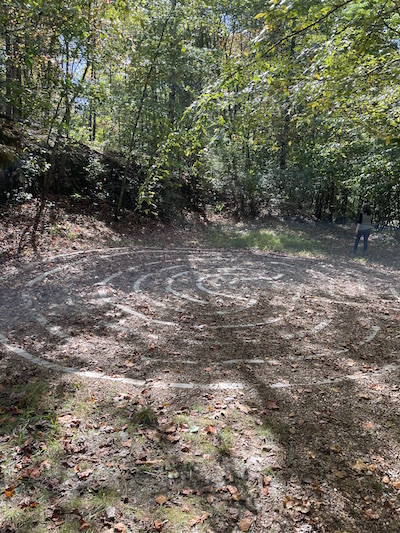
The intriguing thing is that taking a break to “touch grass” works even if you’re not walking or otherwise moving around enough to pump your blood; just sitting outside, even if your “outside” isn’t at all what most people would think of as “nature,” can still have a calming effect.
- Creativity breaks — Even if your workday involves creating, a creativity break can blow that layer of dust off of your mental capacity. You can’t usually step away from work to spend half a day creating, but you can blend your lunch break with some time for painting, drawing, playing a musical instrument, or journaling (by hand, if possible).
- Appreciation breaks — Not every break requires producing something. Sometimes, when your brain is full of one thing, the solution is to fill it with something else, particularly something serene or delightful. Consider taking your lunch break at a nearby museum or art gallery, or just watch tiny humans playing in the park. Appreciate the elegance of ducks swimming on a pond or enjoy the colors and sounds of an open air market.
- Social breaks — While reading social media has downsides, being social does not. I’m an extrovert, and there’s nothing that pumps me up more than taking a break to socialize. Of course, if you’re an introvert, you may not want to wade into loud, involved conversations with colleagues (or, heaven-forbid, strangers), because it may drain you of the mental energy you’re aiming to refresh.
Whatever kind of break you take from daily work, select types of activities that will use different aspects of your brain than you were using to write reports, design web sites, study economics, etc. This allows the “part” of the brain that was overworked to rest and re-set.
Full-Length Breaks: Vacations
I could (and probably should) write a post about the mental, physical, and productivity benefits for taking a long break, whether that’s a real weekend without looking at email or a two-week immersive vacation. Of course, not everyone gets paid vacation, but vacation-length breaks are essential to our health and vigor, which in turn, keep us productive, whether that means making the widgets to building society by raising a family (or, as is often the case, both).
THE BENEFITS OF TAKING A BREAK
When we take breaks throughout the workday, we reap the benefits of better overall physical and mental health, enhanced cognitive function, and improved job performance, all of which will improve our productivity. Let’s look at some of the key advantages of incorporating regular breaks in your work routine.
Enhanced Physical Health
When we incorporate any breaks in our day that involve physical activity or movement, whether it’s stretching, walking, or exercise, it contributes to improved physical health. We improve the blood circulation throughout our bodies (including to our brains!) while reducing the muscle tension that leads to headaches, body strain, and repetitive stress disorders like carpal tunnel syndrome.
We also prevent the various negative health effects of prolonged sedentary behavior. I’m sure you’ve heard the expression, “Sitting is the new smoking.” As I explained in Paper Doll on The Truth(s) About Standing Desks, it’s not that standing desks are that much better. Sitting is bad because when you sit all day, your telomeres (the tiny caps on the ends of DNA strands) get shorter, and the rate at which the body ages and decays speeds up. However, standing all day (like at a standing desk) isn’t necessary all that much better. What is important is movement, and you generally have to take a break from work to get moving!

Walking Photo by Arek Adeoye on Unsplash
Stress Reduction
Varying reports note that workplace-related stress affects up to 80% of American workers. That’s estimated to cost anywhere from $150 billion to $300 billion. That economy-busting stress isn’t going to disappear if we add a few extra breaks each day for mental clarity, but we can turn this around on a personal level.
Breaks in our workday give us the opportunity to reduce stress levels and alleviate the pressure of constantly being focused on work (and the related external expectations place on us). When we engage in any kind of activity that promotes relaxation, we can lower blood pressure (which is good for both the body and the psyche), improve mood, and enhance a sense of well-being.
When we think about stress-reduction activities, we often focus on time-intensive tasks, like a yoga class or long hike, but short-term activities like mindfulness exercises, deep breathing, and brief walks (around the building or around the block) can have similar mental health benefits for reducing stress.
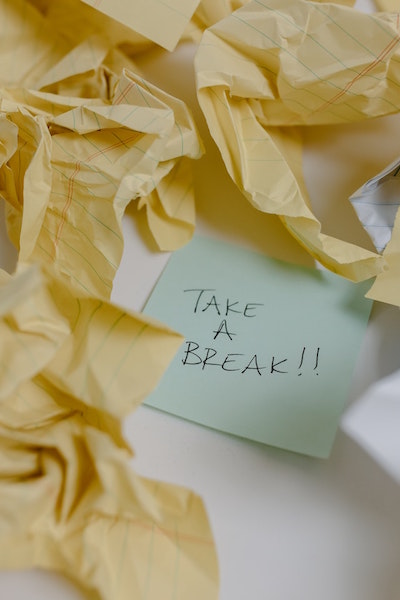
Take a Break Photo by Tara Winstead
Increased Energy and Motivation
When we take breaks throughout the workday, the physical and mental health benefits described above will have a domino effect, knocking down (and out) other problems.
When we take stop what we’re working on to eat, nap, socialize, exercise, or just remove ourselves from hyper-focus on our work, we replenish our energy, both our physical capacity (with improved blood pressure and balanced blood glucose levels) but also our mental capacity.
Conversely, if we don’t take breaks, we’re more likely to suffer from burnout. A 2022 study from Aflac found that 59% of workers were experiencing burnout, and 86% of those reported experiencing anxiety, depression, and sleep difficulties in the prior year, so this is not a negligible concern.
Setting aside time for physical movement, relaxation, and self-care boosts our sense of well-being, which tops off our enthusiasm, and in turn, that improved motivation boosts our ability to perform and sustain our productivity. Whoohoo!
Improved Focus, Memory, Concentration
Contrary to our assumptions that we should always power through our work, our brains need novelty. Researchers at the University of Illinois found that the longer we focus on something, the more likely the occurrence of a “vigilance decrement,” where our “attentional resources” start to plummet. It’s like how we are aware of how cold the ocean is when we jump in, but the longer we’re exposed, the more we get used to it. Or, to use a clichéd metaphor, we’re the frog in the boiling water.
Our brains respond to change, and the longer we go without change, the less efficient they are. Breaks don’t just rev us up; they help prevent the mental fatigue that sets in when we’ve tried to work too hard or too long. When we get lost in those mid-afternoon cobwebs, a break can enhance concentration, allowing the brain to rest and recharge.
Periods of mental rest, whether through mindfulness, activity, or sleep have the power to help us consolidate our memories and improve learning. And this is all as true for kids as for adults!
Short break periods jazz our bodies. We might imagine that a vigorous walk or dancing around to Taylor Swift would pump too much blood to our brains, making it hard to focus, but the opposite is true. Relaxation, whether it’s arrived at through calming activities like meditation or energizing ones like physical activity, will boost cognitive resources. In turn, it enables people to improve and maintain attention, allowing more effective and efficient focus on the work at hand!
Prevention of Decision Fatigue
Decision fatigue occurs when we are faced with too many overwhelming choices without adequate rest, whether for our bodies or our brains. However, breaks can play a crucial role in preventing decision fatigue; just a short pause for the right kind of physical or mental stimulation and/or relaxation can reset cognitive resources.
When we have decision fatigue, we may make poor choices, or procrastinate on making any choices at all. Breaks can give us the resilience to make better decisions and maintain a higher level of productivity, using those decisions to move our projects forward.
Enhanced Creativity and Problem-Solving
We all know what it feels like when our brains get stale. We cease coming up with fresh takes (or even fresh words), which turns into a vicious cycle. If we’re not feeling creative and can’t solve our problems, we’re going to feel bored, unenthusiastic, and stressed out!
Taking breaks fosters divergent thinking and spikes creativity, so we can approach tasks from fresh perspectives. Just stepping away from work for a short time — and focusing on the right energy-boosting replacement tasks — can stimulate more innovative ideas and solutions, improving our problem-solving skills and pumping up our creative mojo.
Per the NPR piece I quoted earlier, Kimberly Elsbach (a Professor Emerita Fellow, Academy of Management University at the California Davis Graduate School of Management), an expert in workplace psychology, noted that never leaving your office or your desk is “…really detrimental to creative thinking. It’s also detrimental to doing that rumination that’s needed for ideas to percolate and gestate and allow a person to arrive at an ‘aha’ moment.” Aha, indeed!
It’s essential to recognize the positive impact of breaks on physical, mental, and emotional well-being so that we can remember to prioritize these pauses and integrate them into our daily work routines. This is key to us fostering balanced, productive approaches to taking on our responsibilities.
Not all breaks are created equal
Pausing work to scroll through social media won’t have the same benefits as the kinds of breaks discussed earlier in this post. First, everything from the death-grip on our phones to the poor posture of arching necks over screens to the blue light of cell phones is bad for physical health; plus, you’re likely to remain just as stationary as when you were working! Beyond that, social media rarely reflects the kind of psychologically neutral or uplifting content that boosts mood or cognition.
Similarly, smoke breaks aren’t good breaks. While they may yield some social benefit, data on smoking’s physical devastation on the body and brain is clear. Moreover, research finds that smokers have thinner cerebral cortex than non-smokers. (The cerebral cortex is essential for learning and memory, so thicker tissue is better.) Smoking reduces the ability to learn and remember, key requirements for productivity!
TAKE A READING BREAK
For further reading on the importance of breaks for health and productivity, you may wish to read:
Breaks During the Workday (Michigan State University)
Give Us a Break (Compass Group)
How to Take Better Breaks at Work, According to Research (Harvard Business Review)
BETTER BREAKS AROUND THE WORLD
In full disclosure, this post started out as a look at how other cultures embrace taking breaks as part of coping with excessive workloads. Instead, this is the prequel, a what-and-why for improving your vitality and productivity with breaks. Next week’s follow-up post, Take a Break for Productivity: the International Perspective is where the real fun will be, as we look at fun and tasty examples of “take a break” culture around the world.
Spoilers: the Swedes take the cake (figuratively and literally) and first place when it comes to taking breaks!
Use the Rule of 3 to Improve Your Productivity
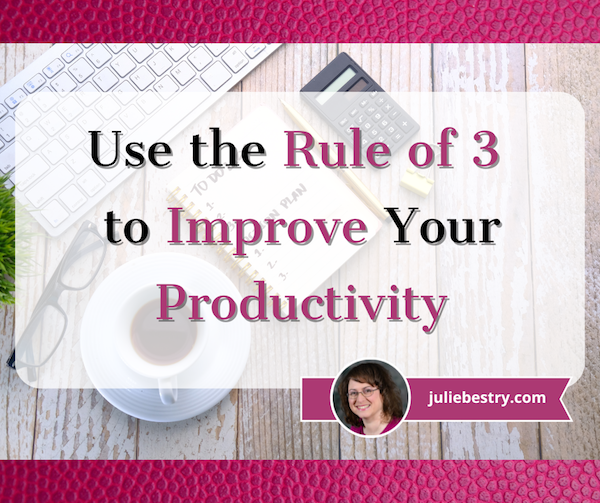
It’s Monday — the first Monday of a new month, of a new quarter, and the last quarter of the year. It may suddenly feel like a lot is riding on getting things crossed of your list so you can make those dreams come true before 2023 is in the rear-view mirror.
RECAPPING THE ESSENTIALS OF TACKLING YOUR TO-DO LIST
Back in May, in Frogs, Tomatoes, and Bees: Time Techniques to Get Things Done, we looked at a spate of productivity concepts for breaking down the hours of your (preferably time-blocked) day to effectively use your discretionary time (that is, the part of your schedule not determined by your boss, school, or firmly-scheduled obligations). We started with the essential elements of accomplishing things:
Knowing what to do — This involves a brain dump to capture every potential task stuck in your head, adding to it from everything in your various in-boxes and buckets (GTD-style), and creating a master list, whether that’s pen-on-paper or a task app.
Knowing what to do first — Prioritizing tasks involves a complex intersection of what is important and urgent. We shorthanded the process with the Eisenhower Matrix (which, as explained in Paper Doll Shares Presidential Wisdom on Productivity, wasn’t invented by the Ike we like, but was attributed to him due to a speech he gave and was made more famous by Stephen Covey).
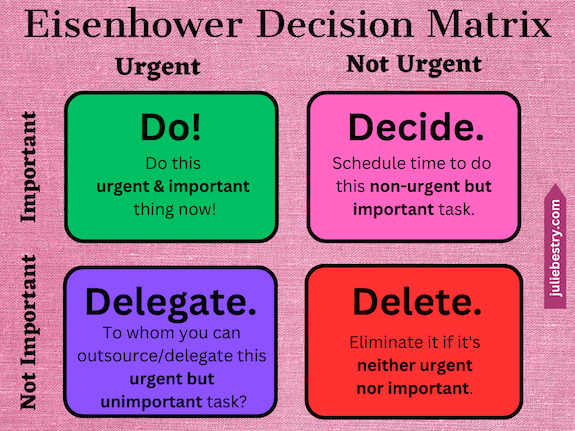
The Eisenhower Matrix gives you the opportunity to (literally or just figuratively) graph each task from your massive brain-dumped list to identify where it falls along a continuum of importance and urgency. From January through mid-April, filing your taxes is important, but it only becomes more urgent as St. Patrick’s Day is behind you and April 15th draws nearer.
Conversely, this Friday’s registration date for an adult education class on French cooking has what appears to be an urgent task; however, if learning how to make Julia Child’s famed Boeuf Bourguignon isn’t that compelling and you were only doing it to please your mother-in-law, it may fall low on the importance scale.
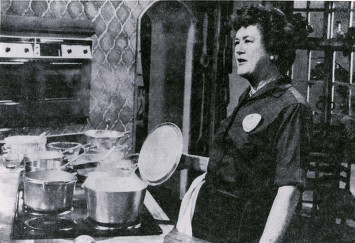 Julia Child on KUHT/By KUHT via wikimedia commons
Julia Child on KUHT/By KUHT via wikimedia commons
A big part of identifying the value of a task may involve looking at what your motivation is. You perform extrinsically-motivated behaviors in order to receive some external reward (or to avoid an external punishment). You might work at a job for a paycheck, work hard in a class to get the grades that allow you to get a scholarship, or make that Boeuf Bourguignon to keep the peace between family members (because it’s hard for people to snipe when their mouths are full).
Intrinsically-motivated behaviors are those that you do because they fulfill you personally. These include passion projects like volunteering, participating in hobbies and sports, or even simultaneously compelling but challenging life activities, like parenting.
Sometimes, you may find yourself frustrated that the very things you value for your sanity-preserving self-care are less valued by society. (This is largely because, as we discussed in our series on toxic productivity, late-stage capitalism values producing work that yields revenue, generally for the people above you in the hierarchy. Sigh.)
Of course, the ideal is to find opportunities for extrinsically- and intrinsically-motivating behaviors to dovetail. When that happens, the things that are important are easier to accomplish because they give you personal fulfillment and extrinsic rewards.
Making something a high priority, per se, doesn’t ensure that you’ll do it, but if that task is important, not just for keeping you out of debtor’s prison but also making your heart sing, you’ll do it less begrudgingly, and if it’s urgent, you’ll find you’re less likely to procrastinate.
You’re probably not going to find that your love of the game will allow you to become a professional pickleball player — more power to you if you do! — but you may find that by becoming more efficient and effective at your for-a-paycheck job will yield more free time to pursue a passion that could turn into a new livelihood.
Once you gauge your each task’s relative importance and urgency, you can move forward to knowing what to get done today (vs. delaying to later in the week), what you might delegate, and what you can hang it in the maybe/someday closet.
Do it! — The final piece of the puzzle involves making time to do what you’ve decided to accomplish.
MANAGING OUR DAYS BY MANAGING OUR HOURS
Back in that post I referenced, Frogs, Tomatoes, and Bees: Time Techniques to Get Things Done, I reviewed well-known and lesser techniques for hunkering down and getting tasks done. I encourage you to read the prior post for details of the methods you find less familiar, but in general, the post reviewed:
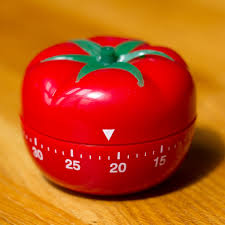
Pomodoro Timer by Michael Mayer CC By 2.0 Deed
- The Pomodoro Technique — At its most basic, the process involves identifying a task to work on now, setting a timer for 25 minutes, focusing on that task for 25 minutes without interruption, and taking a short break. Proponents believe it short-circuits procrastination but detractors note that it prevents getting into a flow state.
- Tocks — This variation on the Pomodoro Technique involves working 45 minutes rather than 25, and adds the step of taking note of distractions as they arise for later analysis.
- The 90-Minute Focus Block — Here, the work blocks expand to 90 minutes and the breaks extend to 20. The expanded time frame is based on research in neurobiology and how our brains use potassium and sodium ions to conduct electrical signals indicates a biological component to our ability to effectively focus.
- 52/17 Method — Splitting the difference between the traditional Pomodoro and the 90-Minute Focus Block, this accents 52-minute sprints of dedicated and intense work followed by mentally-refreshing breaks. It’s backed by behavioral analysis rather than neurobiology.
- The Flowtime Technique — This method starts like all of the others, with uninterrupted work sessions, but instead of ceasing at the behest of an alarm or other external force, you work until you start to feel distracted or mentally or physically fatigued. While this method involves a lot of administrative work for logging both distractions and statistics regarding work patterns, it’s probably the most ideal for creative endeavors, as you ignore the clock and embrace the flow.
These methods work in concert with the principles we’ve discussed regarding time blocking, particularly from these two posts:
Highlights from the 2023 Task Management & Time Blocking Summit
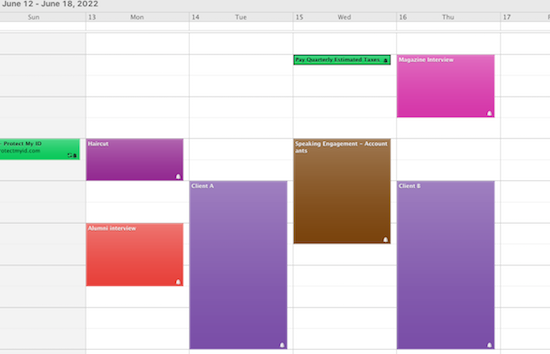
Putting it all together, you figure out what you need to do (overall), identify your priorities, and block your time to ensure ample space in your schedule for accomplishing tasks. Then you get to it!
USE THE RULE OF 3 TO KEEP LIFE FROM GETTING IN THE WAY
All of the above is great for once you get your butt in the chair and have identified a specific task, but let’s face it, getting to that point? It’s a lot.
If you work in an environment where most of your daily schedule can be firmly set in stone (or bytes) with very little to distract you, you’re lucky. But most people experience a multitude of interruptions from co-workers and bosses and tiny humans and senior parents (whether they have physical challenges or just need tech support). Others are dealing with mental and physical health crises and have limited spoons (that is, energy and capacity) to get through the day, let alone accomplish prioritized tasks.
If you’re feeling overwhelmed, there’s a productivity principle that can help you get a foothold when things feel like their going off the rails.
It’s called the Rule of 3.
At its most basic, the Rule of 3 asks you to apply your focused attention, intentionally, to three goals or main tasks for a specific time frame. Generally, and the way we’re going to examine it, that time frame is a day, but you could apply it to a week (or a four-day conference, or a working weekend) or whatever period of time you need.
The key is that you are concentrating on a small number of crucial tasks to maximize your focus, your effectiveness, and your overall productivity. The steps are simple:
Identify three key tasks.
When you plan your day, identify the three most important goals or tasks that you want to accomplish. These may all be work tasks, or they could be a combination: one key work task, one goal item for your family, and one for self-care.

These three should be whatever you think will have the most significant impact on your personal projects, your work projects, or whatever matters the most to you.
And obviously these aren’t the only three things you’re going to get done in a day. You’re not going to skip processing email or picking your kid up from Drama Club or brushing your teeth. We ALL do more than three things in the day. But the Rule of 3 says:
Whatever else I’m doing today, I am absolutely focusing my time and attention to
GET THESE THREE GLORIOUS TASKS COMPLETED!
We’ve already talked at length about the value of the Eisenhower Matrix in prioritizing, and that’s a great place to start, but there are other concepts to help you pick your three key tasks.
Parkinson’s Law states that work expands to fill the time available for its completion. We’ve all had days where we fiddled around and didn’t start working on “the thing” until just about the time we knew we had to being in order to finish on time.
But imagine not doing that. Imagine getting the thing done. And then the next thing. And one more. Imagine not taking all the time available and just taking the time necessary.
Limiting yourself to three tasks creates a sense of urgency. If you recognize that to honor your obligation to yourself, you will focus on achieving the three key tasks, you cut procrastination off at the pass. No fiddling.
Next, experts in cognitive psychology have found that we generally have limited attention and cognitive resources. We get tired. We get bored. We get distracted. We get antsy. We get hangry. By narrowing your focus to a small number of tasks, you are able allocate your attention and mental energy more effectively, which aligns with the Rule of 3’s idea of prioritization.
Finally, Hick’s Law is a psychological principle that says that the time it takes to make a decision increases with the number and complexity of choices. Once you limit your choices for the day to just three key tasks, you are reducing the signal-to-noise ratio and the decision-making complexity. The less you must think about doing, the more you can focus on the task at hand. (And remember, you can always do more of your important (and urgent) things once you’ve done your big three!)
Commit to each of the three priorities and focus.
OK, yes, you still have three things, and you’ll have to decide which of these to do first, and second, and third. You’ll have to figure out into which time block you’ll slot each item. And then you’ll have to blur out two of them while you focus on a third.
In theory, the Rule of 3 calls on you to focus your energy and attention on completing these tasks before moving on to less critical or lower-priority activities. And obviously it discourages multitasking and giving into distractions while working toward finishing the key goals. You can use any of the focused work-session techniques listed up above once you sit down to focus on the task, but before you can focus on the tasks, you have to commit to them, to the idea that you WILL do these three key tasks today.
OK, let’s step back.
Paper Doll recognizes the need for a reality check. You will not always be able to tackle all three key tasks first before getting on with your day unless your efforts do not require the involvement of other human beings (whether tiny humans or large egos).
For example, last Friday, my car was finally ready for pickup. It’s been a long two months since it was stolen, recovered, and had to go through many, many repairs. (For reference, Organize to Prevent (or Recover From) a Car Theft tells the initial tale; everything since has been a nightmare of dropped balls, global supply chain failures, and random poopyheads.) But I also wanted to get my flu shot and had two essential financial tasks.
The car issue was actually a series of interlocking tasks. I had to confirm the specifics with the body shop, and wanted to view and approve all the work before paying my deductible and returning the rental car, which involved more phone calls and scheduling, and I needed to approve the last round of digital insurance payments.
The car goal was both important and urgent, as I didn’t want to be charged for further days of the rental car, and frankly, I missed my adorable red Kia Soul as if it were a child away at summer camp for far too long. But while most of the car’s mechanical and body work were completed, there were a few painting-related flaws, and a review of the final no-longer-estimated estimate yielded lots of new questions. However, by staying single-minded on the task and not being distracted by calls, texts, and emails, it eventually got done, and I felt an immense sense of relief and completing this key task for my day.

Getting my flu shot involved confirming that my pharmacy had the flu vaccine and that no appointment was necessary. (Last year, appointments were required and only given on certain days of the week, which often conflicted with my client schedule.) And the bank tasks, though easy, were dependent in part on the arrival of the mail, and the fill-in postal carrier did not deliver the mail until close to 6 p.m.
Celebrate your wins!
Being successful with the Rule of 3 means acknowledging completion of the task and feeling satisfaction. Far too often, we rush through what we must do without celebrating that we’ve actually done it. However, taking the time to celebrate wins improves your confidence, boosts your motivation, and will make it easier to approach other tasks (especially long-avoided ones) with verve.
For a sense of psychological benefit of this step in completing key tasks (particularly those we might define as “adulting,”) I direct you to Hazel Thornton’s recent post, High Five Friday. She explores turning this celebration of completion of key tasks from a solitary act into a social one, and as I’ve watched people follow Hazel’s lead, the evident delight people experience is palpable!
Re-evaluate, or Lather/Rinse/Repeat: The “What’s Next?” Step.
OK, so you figured out what to do, did it, and gave yourself an atta-girl or atta-boy. Now review the process. Evaluate your progress to determine the big question: what’s next?
(Fans of The West Wing recognize the power of those two words. Lin-Manuel Miranda created this video for the late, great The West Wing Weekly podcast. There are two profanities within (at :50 and 1:04), so please be forewarned.)
This is the time to evaluate your progress (and your process for getting there). Determine the next three most important tasks to focus on, whether that’s for the remainder of today, or for tomorrow, or your next key time period.
You’re creating a continuing cycle of identifying key tasks, prioritizing them, completing them, doing a happy dance and high-fiving yourself, and reevaluating what worked and what didn’t. All of this is designed to help you maintain a higher level of the good, non-toxic kind of productivity that keeps you aligned with your ultimate goals.
Why does the Rule of 3 work?
First, it’s simple, so you may actually try it. Everyone loves a new productivity technique, but the more working parts, the less likely you will be to do more than think about using it.
Second, three is a magic number.
Whether it’s “lions and tigers and bears” or “faith, hope, and charity” or if you’ve been hearing a lot about the Roman Empire lately, “friends, Romans, countrymen.” It’s easy to keep three daily priorities in your head, so if you check in with yourself at lunchtime or mid-afternoon to see how you’re doing on your goals, you can mentally measure your progress in seconds.
Finally, and most importantly, the Rule of 3 is an effective approach because it prevents the overwhelm and decision fatigue that often results from having a long, fiddly, and overwhelming to-do list.
The Rule of 3 is an effective approach because it prevents the overwhelm and decision fatigue that often results from having a long, fiddly, and overwhelming to-do list. Share on XNarrowing your focus to just three tasks sets you up to more efficiently allocate your time and energy, so you can accomplish more meaningful things. Again, this may be work, but could be personal enrichment or self-care. Completing a project for work may be important, but exercising and having essential medical appointments and living a fulfilled life are of inestimable importance and urgency. In other words, you matter. Paper Doll says so!
ADAPT THE RULE OF 3 TO YOUR NEEDS
As with any productivity concept, the Rule of 3 is a only guideline. There is no “boss” of the Rule of 3 in the same way that practitioners of GTD look to David Allen; indeed, I’ve done extensive research and have yet to find an originator. I originally read about the Rule of 3 almost ten years ago in Chris Bailey‘s The Productivity Project: Accomplishing More by Managing Your Time, Attention, and Energy.
Paper Doll Says: Don’t Get Stuck in a Rut — Take Big Leaps
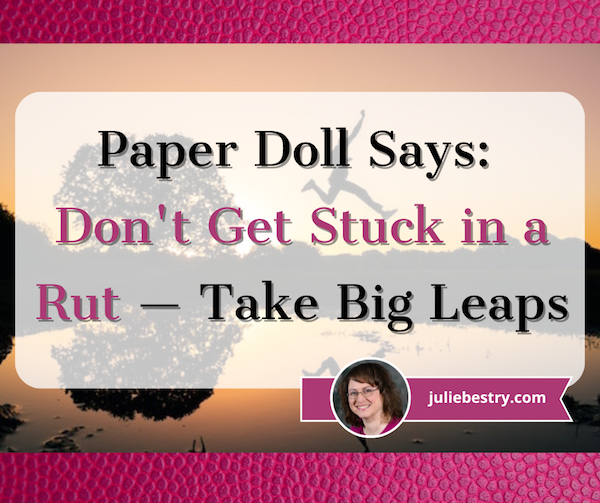
Are you feeling stuck? When you flipped the calendar to the new month and realized how close we are to the end of summer, and even the end of the year, were you struck by a gnawing feeling that you’ve been mired in the same place for too long?
Are your New Year’s resolutions the same every year? Do you make the same wishes, have the same complaints, and feel like you’re Groundhog Day-ing it through life?
At the end of May, in Organize Your Summer So It Doesn’t Disappear So Quickly, we talked about how the lack of structure, novelty, and sensory clues for the passage of time (along with lack of self-care and an excess of technology) can make us sluggish. We may keep doing the same things, over and over. We may not notice that sometimes we are very efficiently doing the wrong things.
Perhaps it’s time to stop doing some things, start doing other things differently, and to take bold strides on other things altogether.
Although most people think of professional organizers in terms of their possessions, I usually talk about how I help people manager their stuff. Stuff is more complex than just possessions. Your stuff may be what’s piled up on your desk or precariously balanced on your kitchen counter or squished into your closet.
Alternatively, the stuff causing you overwhelm may be the excess in your schedule rather than your space. The temporal, rather than the tangible, can also weigh you down.
However, it’s possible to be crowded out of your enjoyment of life by other than too much in your space and schedule. You could have so much going on in your brain that you can’t accomplish what you want.
The stuff in your head could be ADHD. It might be anxiety or clinical depression. And it certainly could be fear. In fact, several years ago, in Paper Doll Talks With Smead About Fear & Disorganization, I shared how fear holds us back.
Too much, or at least too much of what doesn’t serve you, can keep you from moving forward, from taking leaps. Today, we’re going to look at how to get out of a rut and then consider taking bold leaps forward.
HOW TO GET OUT OF A RUT
Investigate Your Life
Pull on your Sherlock Holmes deerstalker hat, twirl your Hercule Poirot mustache, jump in your Nancy Drew blue roadster, and think about what’s feeling stuck in your life. Let’s start by identifying the symptoms of being in a rut.

Have you lost your enthusiasm? If you can’t pinpoint obvious reasons (lack of recuperative sleep, diagnosed depression, a bed that’s just too comfy) for not wanting to get out of bed, you may be in a rut.
When someone asks you what you want — what to do, what (or where) to eat, or where to go, whether for the afternoon or for a holiday — do you mentally check out? Sometimes, when you’re in a rut, you can’t even imagine different ways of doing things.
You’re not broken. You’re probably in a rut.
The next step is to figure out why? Is it you, or is it what’s in your space, your schedule, or your head (that shouldn’t be) or what’s not there that should be? Understanding the root cause is essential.
It is too much of something? Is there clutter that’s keeping you from entertaining in your space or feeling relaxed enough in your home to pursue your activities? It may be obvious, as this is an organizing blog, but check your space for excess. Are you in a rut physically because you always have to move things off the counter to reach the microwave, or pull suitcases out of the closet to get to your clothes?
Do you have too many activities filling up your schedule? I don’t just mean work-related, though too many Zooms or in-person meetings can wear you down. Maybe your kids are signed up for so many after-school activities, which means you’re constantly schlepping them to-and-fro. Maybe you’ve been in the same clubs with the same people for what seems like forever.
Have you outgrown the life you’re leading? I’m not suggesting you need to take the 10:25 to Reno and leave your job and family behind. But there may be aspects of your life that no longer fit, like a too-small pair of jeans that makes you feel like you can’t really breathe.
It’s possible that you’ve grown out of the things you’ve collected. When my sister was in college, she had a few small elephant-themed items, and soon it became habitual for people to give her elephants in the form of earrings and knickknacks and stuffed animals. Somewhere after a few decades, I noticed that she wasn’t displaying the elephants. She was over the elephants.
And again, you may have things in your schedule that don’t serve the person you are, or the person you want to be. You calendar might not be overloaded, but the things in your calendar may no longer be giving you joy. Are you going to that book club because you’ve always gone or because you love the books and the people? (If you’re going just because you love the cheese plate, be assured that you really can buy that yummy cheese and eat it all yourself.)
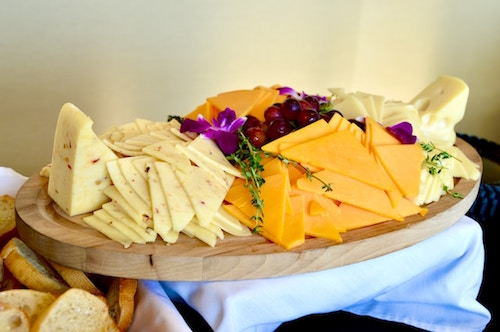
Cheese board photo by Andra C Taylor Jr on Unsplash
Track the Clues: Routine or Rut?
If, while playing detective, you find it hard to actually detect what’s wrong, you may need to get more granular. Pick a random week (or start with a day if a week seems overwhelming) and take note of what you do and how your week (or day) flows.
- Are there things you do the same way, over and over?
- Does each day’s schedule blend into the next?
- Do you have trouble differentiating between the average Monday and the average Thursday? (Does every day feel “average?”)
You may be thinking, “But Paper Doll, I have a routine! Isn’t the best way to make sure everything gets done to have a routine?”
Yes!
But also no, not always.
Routines and ruts are related concepts, but they have distinct differences:
A routine is a planned and organized set of tasks or activities that you regularly follow. Your laundry routine makes sure that you don’t have to send your tiny humans to school in Wonder Woman bathing suits under their clothes. Your morning routine gives you the centering, mindful energy, nutrition, and caffeine to keep you from smacking your annoying co-workers with a keyboard.
You design your routines to help you manage your time, reduce stress, and increase efficiency.
Conversely, a rut is a stagnant pattern, one that makes you feel unmotivated or unfulfilled. When you’re in a rut, you may find yourself going through the motions without any sense of intentionality. You’re doing what you’ve always done, getting what you always got. (The longer you’re in a rut, perhaps the less you get back?)
A routine is a deliberate; you structure the sequence of actions and schedule them to create a order in your life. A routine empowers you. By contrast, the stagnant nature of a rut — because you are no longer deliberately evaluating the success and productivity of the routine but just mindlessly abiding by it — may leave you feeling unfulfilled at best, and trapped at worst.
Ruts may occur in our diets, our personal activities, our careers, or our relationships. While Woody Allen isn’t exactly a favored source of inspiration these days, the movie Annie Hall has an apt quote.
While routines can be healthy and productive, ruts are usually associated with a lack of progress and satisfaction in life. We often consider “improvement” to be the key sign of progress, but in some cases, breadth, depth, or variety may also be evidence of progress.
Putting it all together, a routine helps you achieve a groove. But sometimes, treading that same ground, over and over, turns a groove into a rut.
The Magic of Intentionality
Once you see where your life is lacking progress, variety, or fulfillment, you can achieve more of what you want by intentionally making changes in various ways:
- Subtract — Look at what’s blocking your energy and take those obstacles away. If you’re not doing your workout because there’s junk piled up in your workout room, use all the resources we often talk about to sort, clear the clutter, move things to more logical homes, and/or donate, sell, or discard what no longer fits your life.
If there are activities that no longer float your boat, jump overboard. You might have to relinquish responsibilities and it could momentarily inconvenience others to have to find someone to handle the role you’ve done uncomplainingly for far too long. That’s OK.
Offer to help your replacement with the transition, but stand firm on letting go of tasks that don’t nourish you personally or professionally.
- Add — If you’re in a rut, just taking things away probably won’t solve all of your problems.
Having more empty space may mean you don’t have as much housework to do, or it could make you uncomfortable. If you finally eject all of your ex’s stuff from the house, the emptiness may make your space, and even your life, feel cold or lacking. Mindfully consider what you might enjoy having in your space.
Similarly, emptying your schedule of undesirable obligations may not be enough. Having all that extra time may initially make your life feel empty. You needn’t fill every moment all over again with different activities, but do open your mind to exploring what you may have not realized you were missing.
Start by adding self-care activities to slowly fill up a small number of those relinquished schedule slots. Remember to make time for sleep, mindfulness or meditation, exercise, nutrition, and uplifting social relationships. Feed your body and your mind to jump out of that rut.
Daydream and allow for possibilities you never previously considered. Just because you never considered yourself artistic or creative before doesn’t mean you might not explore a painting class or community theater. Maybe you’ll try to acquire new skills or knowledge relevant to your goals, but remember that personal fulfillment or enjoyment is a good enough reason to have new experiences.
Not everything is about productivity. Let joy be enough.
- Prioritize — Once you know the negative effects of the rut you were in and have considered how you want to replace (or enjoy the absence of) the tangible, temporal, and cognitive clutter you had before, figure out what’s most important to you.
Do you want to work on your body? Your spiritual well-being? Your professional development? Do you want to taking dance lessons or spend more time reading?
Spend some time writing down everything that was missing from your life when you were in a rut, and what you want to experience instead. Then pick your top two priorities.
Why two? If you are working on just one priority, and achieve it, turning to the next on your list will make you feel like you are starting from scratch, which can be demotivating. Focusing on one priority, but having a backup that gets a little attention, means you always have an proactive alternative to consider when you need a pause.
Why only two? Focusing on changing more than two areas of your life simultaneously usually leads to overwhelm. The goal is to lighten your life, not weigh you down.
- Break it down — Once you figure out what you want, figure out what gets you there.
Let’s say your rut was dietary. No matter how much you love tacos, having Taco Tuesday every week, with no change in the ingredients or dining companions or cooking responsibilities can be a bit much. Break your proposed life changes down into small steps and reconsider everything.
Maybe your spouse will cook more often; perhaps your family will experiment with group meal planning and grocery delivery, eliminating Thursday shopping trips (and the need for a babysitter).
- Reinvigorate your routines — Remember what we said about the difference between ruts and routines. It’s OK to have routines; just be intentional about them.
Getting out of a rut doesn’t mean abandoning all structure from your life and schedule. It doesn’t mean never cleaning the bathroom; it does mean giving yourself permission to delegate the task your teenager (either as a life lesson or in return for car privileges) or hire a cleaner.
It doesn’t mean never taking your kids to their activities, but it does mean exploring the alternatives — trading off with your co-parent, with other kids’ parents, or (if your kids are old enough) arranging for a car service — so the time you spend going to your children’s activities are more often related to seeing or participating in those activities (as a supportive audience or coach) because you are now more fulfilled.

Use the time management skills you’ve learned from this blog and elsewhere to use the Eisenhower Matrix to put more of your attention on tasks with high importance and/or high urgency and reject or lessen the things with lesser value to your life.
- Replace the bad stuff with good stuff — This is a follow-up on the advice to add and subtract. If you were in a nutrition rut, you might eliminate the purchase of empty calorie foods. If your life has been filled with the equivalent of empty calories, eliminate the distractions of app notifications, clutter in your workspace, and interruptions from people and relationships that don’t fit your greater good.
- Stay flexible — If you’ve been in a rut for a long time, empty space (in your home, your schedule, or your mind) may feel scary. You could be tempted to create lots of new routines with just as little flexibility as before, and you’ll find yourself worn down again. Leave yourself open to adapt to new possibilities. Nobody gets out of a rut overnight. Have patience with yourself.
- Welcome support — Reach out to supportive friends or family for help brainstorming, noticing habits, or seeing new pathways. Professional organizers and productivity coaches can help you find new ways to make changes in your space, schedule, or thoughts. If you’ve been weighed down by more problematic thoughts or feelings, consider how a therapist can provide valuable perspective, guidance, and support. You’re not alone.
For more on excaping a rut:
You 2.0: How to Break Out of a Rut (Hidden Brain podcast)
How to Get Out of a Rut in 8 Steps (Master Class article)
How To Get Out of a Mental Rut, According To Psychologists (Well+Good article)
Getting Off the Treadmill: Six Ways to Break Out of a Rut (Science.com article)
Finally, and especially as we’re approaching the Jewish New Year at the end of this week, I encourage you to revisit Organizing A Fresh Start: Catalysts for Success for motivation and support.
HOW TO TAKE A BIG LEAP
The opposite of a rut can be a leap.

Sunset Leap by Kid Circus on Unsplash
Once we figure out what to stop doing, and start examining what we’re going to do differently, we give ourselves permission to think on a grander scale.
We have lots of reasons why we don’t take leaps, and they are similar to why we stay in ruts. Why make waves? Why risk new problems? We generally step back from taking leaps because of fear, and those fears may or may not be warranted, but they definitely keep us in limbo, wanting but never trying.
I’m a cautious person by nature. I suspect that’s true of many professional organizers. We’d rather prevent problems than have to fix them, even though our arsenal of skills helps us do both.
In college, I never took Italian because I feared doing damage to my GPA, and I was a decade out of graduate school before I realized that never once after I left academia did anyone, ever, ask about my GPA. Studying Italian these five years has brought joy to my life; my only regret is that my introduction came from the cartoon characters in Duolingo and not the the professors and fellow students at Cornell 35 years earlier.
There’s no wrong time to take a leap. There are certainly wrong ways. Selling your wares for magic beans isn’t smart; giving up your well-paying career to become a professional surfer when you’ve lived your entire life in Iowa probably won’t yield a secure life. But I’d like to share the advice on leap-taking I’ve gleaned from a few articles I’ve read lately.
Regrets, I’ve Had a Few
In Woulda, Coulda, Shoulda: The Haunting Regret of Failing Our Ideal Selves, the author looks at the published research of Cornell University professor Tom Gilovich and former grad student Shai Davidai in The Ideal Road Not Taken: The Self-Discrepancies Involved in People’s Most Enduring Regrets.
They identfied three elements of our sense of self, the:
- actual self — the attributes a person believes they possess.
- ideal self — the attributes people would ideally like to possess (including their “hopes, goals, aspirations or wishes”)
- ought self — what a person feels they should have been, based on duties, obligations and responsibilities.
Through six experiments, Gilovich and Davidai looked at two areas of discrepancy — what they call ought-related regrets and ideal-related regrets.
When people look back at their lives, they cope fairly well with any discrepancy between what they thought they ought to have done, in terms of duties and responsibilities, and what they actually did. Basically, we forgive ourselves when we feel like we ought to have dieted and exercised, we ought to have been more attentive to our studies, or we ought to have been better at managing our money.
Conversely, when we fail to take actions that could allow us to become our ideal selves, those regrets remain unresolved; we don’t get over our failure to act to become whomever we might have been.
Most tellingly, Gilovich said, “In the short term, people regret their actions more than inactions, but in the long term, the inaction regrets stick around longer.”
This brings to mind two of my favorite quotes:
“It is never too late to be what you might have been.” ~ George Eliot
It is never too late to be what you might have been. ~ George Eliot Share on X“The life you have led doesn’t need to be the only life you have.” ~ Anna Quindlen
The life you have led doesn't need to be the only life you have. ~ Anna Quindlen Share on XRisky Business
Do You Rarely Take Risks? Maybe it’s Time You Do, talks about how mindful risk-taking can be extremely rewarding. As we age, we’re more likely to settle into our comfort zone, and that coziness of comfort zone can easily leave us mired in a rut.
The article shares the advice of clinical psychologist Carla Marie Manly, who warns that as we age, we tend to turn more toward fixed mindsets than growth mindsets, narrowing the new opportunities we give ourselves. Manly advises that we first work to be conscious of the fact that we’re prone to lock down, which enables us to be aware of our fear and then deal with the related discomfort.
Manly argues in favor of acknowledging our discomfort but choosing risks that we find compelling. They don’t have to be big risks; the “riskiness” might be as small as ending up with a meal you don’t love as much what you usually order. But organizing your life to experience things that are new, different, and outside of your comfort zone increases the chance that you will increase the size of your comfort zone!
Respect Yourself. Don’t Reject Yourself.
One of the best things I’ve read lately related to taking leaps came from this article from Ness Labs entitled Turning Fear of Failure Into Increments of Curiosity.
So often, when we fail to take a leap, we do it out of fear of failure, particularly the fear of others judging us, especially if we fail.
The focus of this excellent piece is that we should approach bold strides as if we were scientists. The scientific method says, “Hey, let’s try this and see if it turns out the way we expect.” And if it doesn’t? Science says, “That’s cool, too! Because now we know!”
The article recommends making small moves and iterating again and again, creating bigger growth loops. It’s a short piece, and I recommend reading at least the end, where the author walks through the steps of an intentional life experiment for getting past the fears that keep us all from moving forward.
But my favorite part of the piece was near the beginning. The author, Anne-Laure Le Cunff, recalls being ill at ease about applying to a selective academic program abroad; she feared she would not be accepted. Le Cunff’s mother noted, “It’s not your decision to make.”
This was a “wow” for me. When we hesitate to take action out of fear that we will not win, or be accepted, or hired, or loved, we are taking the opportunity to reject or accept us out of the hands of the panel or the company or the person whose decision it should rightfully be.
The Big Leap — It’s Your Decision
Nobody can make the decision for you as to whether you will make bold strides, or when, or how.
The following short film examines a dilemma at the top of a ten-meter diving tower: to leap or to risk the embarrassment of climbing all the way back down. I think you’ll find it worth the price of admission. (Note: Almost all of the dialogue is in Swedish with English subtitles, but there are a few English profanities. Consider yourself forewarned.)
Fortune favors the bold, or so goes an ancient Latin proverb. Would you leap?
Paper Doll and Friends Cross an Ocean for Fine Productivity Conversations
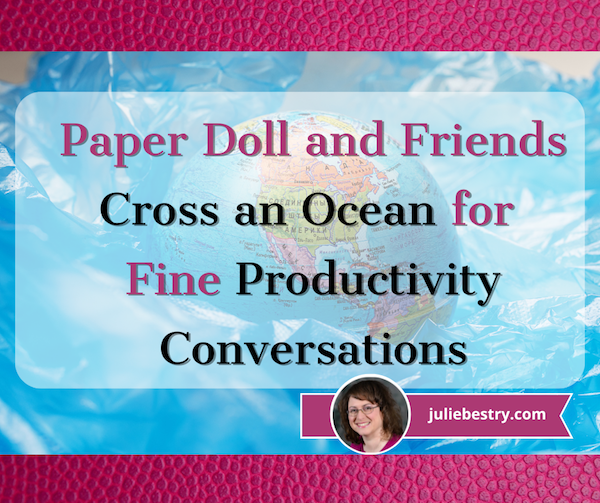
When you love what you do, it’s easy to make connections with people involved in the same things. This is especially true for me when I get around people who like to talk about organizing and productivity. (I mean, who wouldn’t want to talk about productivity and organizing?)
DO YOU HAVE AN ORGANIZED PERSONALITY?
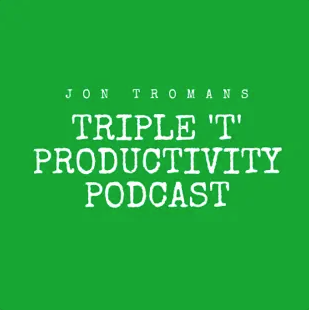
At the start of May, I saw that my friend, accountability partner, and friend-of-the-blog Dr. Melissa Gratias had posted that she was a guest on Jon Tromans’ Triple “T” Productivity Podcast in an episode called Productivity. It’s all in your mind! A chat with Dr Melissa Gratias. Jon’s in the UK, Melissa’s in Savannah, and the conversation was out of this world!
(You know Melissa from many posts, but especially Paper Doll Interviews Melissa Gratias, Author of Seraphina Does Everything!)

Melissa and Jon pondered the age-old question of whether we are born productive (or unproductive), or whether it’s matter of environment and training. As Melissa is a trained in psychology (she has a Ph.D. in Industrial and Organizational Psychology!) she offered insight based on “the Big Five personality traits” in the Five-Factor Model of Personality (also called The Big Five Model), and particularly the role of conscientiousness. I found this fascinating and jumped in to read more!
For those who haven’t taken a Psych class since college, the theory (which can go by the acronym CANOE or OCEAN) says that personality can generally be examined in terms of five core factors, each along a continuum:
- Conscientiousness — You might think that being conscientious is just a good policy. However, as a character trait, one can over- (or under-) do it. Too high on the conscientiousness continuum, and you might be a perfectionist or workaholic; too low and you might give in to impulsiveness, irresponsibility, and disorganization. The goal is to be organized, responsible, and productive without going overboard into the toxic productivity realm we’ve been talking about lately here on the blog. Melissa talked with Jon about the correlation of the conscientiousness personality trait in seeming to be “naturally” organized.
- Agreeableness — Understandably, the continuum here ranges from those who are too trusting, selfless, and possibly even gullible on the high end to being overly suspicious, uncooperative (or — eek! — manipulative) on the low end. Someone striking a balance will be compassionate, respectful, and trustful to a logical degree.
- Neuroticism — Note that this refers to the tendency to experience negative feelings. Neuroticism feels like the one odd duck in the model, because one would assume you wouldn’t want to be neurotic at all! As you’d expect, at the high end of neuroticism, someone might be anxious or depressed, pessimistic, and even filled with shame. But on the low end, it’s apparently possible to have too little neuroticism, leading to a sense of shamelessness. The safe harbor here is being confident and calm,
- Openness to Experience — Those toward the high end may be seen as imaginative or creative, spontaneous, and curious, while those in the comfortable middle may be prefer practicality and routine, and at the low end might seem inflexible.
- Extraversion — The range of extraversion is wide, and someone might range from attention-seeking to reserved. Basically, you want to be out there but not too out there! (Someone should have discussed this with 7-year-old Paper Doll.)
If you’d like to read more about this model, these articles offer a good start:
Big 5 Personality Traits (Psychology Today)
Big Five Personality Traits: The 5-Factor Model Of Personality (Simply Psychology)
What Are the Big 5 Personality Traits? (Psych Central)
For what it’s worth, I did a self-test at BigFive-Test.com (having searched for a free test, I picked one at random) and got the following results. As you can see, I score highest on conscientiousness, which would seem to validate Melissa’s wise thoughts on Jon’s podcast, given my field of work.
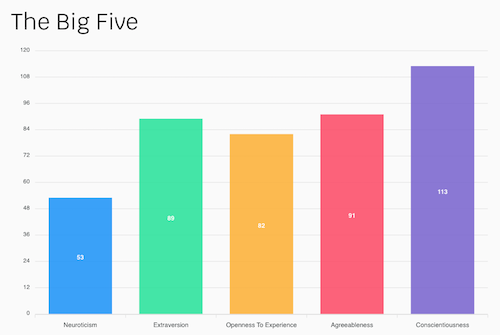
The results also looked at various characteristics within each trait. For example, extraversion looked at friendliness, gregariousness, assertiveness, activity level, excitement-seeking, and cheerfulness. Conscientiousness broke down the score for self-efficacy, orderliness, dutifulness, achievement-striving, self-discipline, and cautiousness.
And speaking of caution, this was just a free internet test, probably more valid than Which Grey’s Anatomy Character Are You? but not as valid as working with a psychologist or expert in this kind of testing. Also, in case you’re wondering, at least according to the internet, I’m Lexie Grey.
Lexie Grey via GIPHY
(Even considering the dangers of the Red Wedding, something tells me I should have gone with a Game of Thrones character quiz!)
But I digress. We were talking about Jon Troman’s Triple “T” Productivity Podcast.
JON TROMANS’ CAST OF CHARACTERS
I was charmed by Jon’s interview with Melissa, which mixed fun and lively conversation with a deep dive into philosophies of productivity. Although I did not know Jon, I recognized his name as a fellow Evernote Certified Expert, and made a point to learn more about him.
The next week, he profiled a professional organizer, Lucy Milligan Wahl, owner of LMW Edits in San Francisco for the episode Maximizing Productivity through an Organised Life. A chat with Lucy Milligan Wahl.

Lucy is a NAPO colleague, and while she and Jon did discuss Evernote and organizing, I was most taken by her approach to making a symbolic (and clear) division between life and work through ritual. It was a compelling chat, and I felt like I was listening in on a cool conversation at the next table in a café.
By the next episode, Me And My Evernote With Ray Sidney-Smith, I was definitely hooked. Ray being on the podcast was a double-delight for me. First, you’ve already met my productivity buddy Ray in many Paper Doll posts, so you’ve read how much I respect him, like in Paper Doll Picks: Organizing and Productivity Podcasts. He is one of the kindest individuals I’ve ever met, with a wicked/quick/clever sense of humor, and a wisdom surrounding productivity concepts in general and Evernote and David Allen’s Getting Things Done in particular.

But Ray is also special to me because he was my very first Evernote friend. We were in the same certification class, way back in 2015, and I am always agog at how much he manages to do, because is he reminds me of that movie title, Everything Everywhere All at Once.
He works a day job, he knows everything there is to know about Evernote, he leads in-person and virtual productivity meet-ups, and as he disclosed in the episode, he’s read more than 400 productivity books! According to my Goodreads book list, I’ve read a lot, but 400?!
For what it’s worth, I messaged Ray to see if he’s got a written, sharable list of his books, but sadly no. To be honest, I’m a bit shocked he doesn’t have an Evernote note listing every title, but he’s taken my request on board and put it on his Maybe/Sometime task pile. I’ll be sure to let readers know if he comes forward with a full accounting of all of the titles!)
MEETING THE MAN HIMSELF
At this point, having listened to three of my friends and colleagues get to chat with Jon (and then going back to hear his convo with our fellow Evernote Certified Expert Vlad Campos, maker of fascinating technology, productivity, and Evernote videos), I had to let Jon know how much I appreciated his stuff.
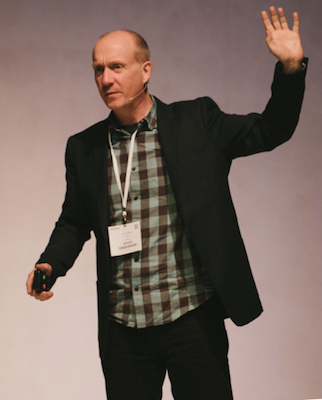
I did a little poking around and found that, like me, he had a whole prior career in broadcasting! (You can be sure that, off-microphone, had and I have now had some rollicking conversation about that era of our lives.) He also builds websites, develop marketing campaigns, and works with businesses to improve their digital content. Plus, he hosts the Not Another Marketing Podcast that covers the whole realm of digital marketing.
On top of it all, which is what made me realize he was more than just the guy I knew from the Experts forum, he started the Taming the Trunk newsletter and community. (The “trunk,” for the uninitiated, is the Evernote elephant logo’s trunk.) And from there, I guess creating the Triple “T” (get it? “Taming the Trunk?) Productivity Podcast was a natural extension.
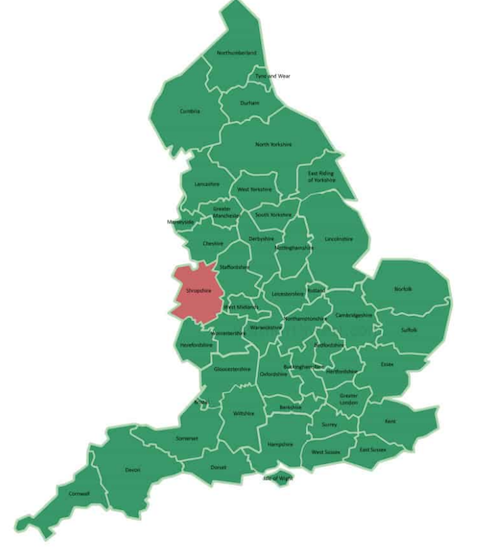
Jon’s located on the Welsh border in Shropshire, West Midlands, and while I did get to go to England, Wales, and Scotland on my 2019 tour of the UK, I never got that close to where he is, which is a real shame because (as you’ll hear if you listen to any of these podcast episodes) he and his charming accent are a delight!
Once we realized all the connections between us, Jon was lovely enough to invite me on his show, and we recorded the episode, Me and my Evernote with Julie Bestry, last week. I think you’ll be able to tell that we had a ball!
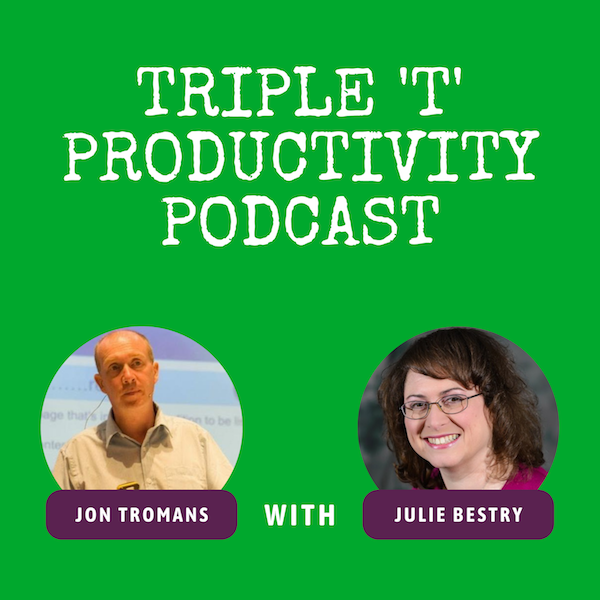
Jon asked me about all my favorite topics, from my take on paper vs. digital to what I really think of the idea of scanning all of your papers. Plus, Jon’s got a short list of questions he asks all of his guests, including a knockout of a question about life advice, which gave me a chance to share the always-brilliant wisdom of Paper Mommy.
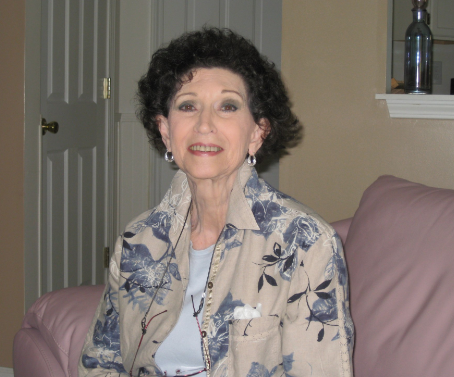
You can listen to all of these episodes at the website episode pages to which I’ve linked above or at the episode archive, but for the full experience, subscribe and listen to the Triple “T” Productivity Podcast at Apple Podcasts, Spotify, Amazon, and (as they say) wherever you get your podcasts.
I invite you to listen to my episode and let me know what you think.





Follow Me